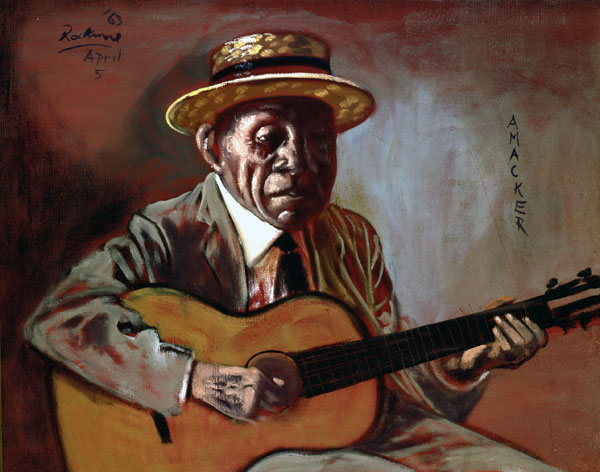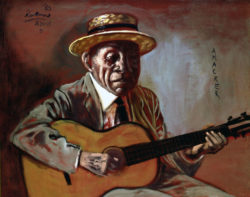Noel Rockmore
Noel Rockmore moved to New Orleans in 1959 and established himself in the French Quarter where he painted portraits of jazz musicians in the early 1960s.

Courtesy of Roger H. Ogden Collection
Amacker. Rockmore, Noel (Artist)
Noel Rockmore (born Noel Davis) moved to New Orleans in 1959 after a successful early career as an artist in New York City. He established himself in the French Quarter, painting in a studio in the house of fellow artist Paul Ninas, and became recognized for painting jazz musicians in the early 1960s in his Preservation Hall Portraits. Rockmore is commonly described as a “New Orleans artist,” yet the arc of his career, as well as his path to New Orleans, was complicated. In his New York years, where he worked as Noel Davis from 1948 to 1959, Rockmore’s paintings were exhibited and collected by national museums including the Metropolitan Museum of Art and the Museum of Modern Art. Active in the French Quarter from 1959 to 1995, he painted French Quarter personalities, including artists, musicians, writers, actors, and performers.
Rockmore was a prolific artist, as affirmed by his New Orleans dealer, Larry Borenstein, who noted that by 1973 Rockmore “had produced about two hundred graphics (etchings, aquatints, mezzotints, and lithographs), in excess of two thousand paintings (oils, egg tempera, and acrylics) and four to five thousand drawings and watercolors and gouaches, countless sketches, illustrated letters, and other less formal art pieces.” By December of 2011, this number was updated in an Associated Press news article, which described Rockmore as a “Picasso-like figure who combined the mythological and real,” indicating that he “produced fifteen thousand oil paintings, temperas, collages, and sketches during his career, then died in obscurity.”
Beginning at an early age, Rockmore demonstrated creative abilities in both art and music. He was born on December 15, 1928, to Gladys Rockmore Davis and Floyd Davis, both successful artists in New York, and had a sister, Deborah Davis. He studied violin, piano, and guitar, and it was assumed he would become a musician. Rockmore later noted that when he was eight and Deborah seven they “frequently performed impromptu recitals of Schubert sonatinas.” However, after contracting polio, he devoted himself to painting and drawing while he recovered, and by 1939 he was studying with noted artist friends of his parents, including Raphael Soyer and Yasuo Kuniyoshi. He attended the Putney School in Vermont and after graduating, in 1947, studied at the Art Students League in New York. In 1948, when Rockmore was only 19, noted art collector Joseph Hirshhorn bought one of his paintings, the first of many works acquired for Hirshhorn’s collection, later donated to the Smithsonian Institution for the formation of the Hirshhorn Museum in 1966. Rockmore set up a studio in the Cooper Union and began a series of portraits of figures from New York’s Bowery, and later painted animals, first at the Museum of Natural History, then at the Ringling Brothers Circus.
Rockmore married Elizabeth Hunter in 1951, beginning a period, from 1951 to 1958, when he became a family man and a successful artist in New York. He and his wife had three children—Christopher, Robin, and Emily Davis—and lived at the Hotel Des Artistes on Manhattan’s Upper West Side, before moving to Brooklyn Heights. During these years he exhibited at the Harry Salpeter Gallery, was invited to join the National Academy of Design, and was exhibited in New York at the Whitney Museum, Metropolitan Museum of Art, and the Museum of Modern Art. However, selecting the free-spirited life of an artist over the responsibilities and conventions associated with marriage, Rockmore divorced Elizabeth in 1958 and cut ties with his children for years. He moved to Coney Island and began creating paintings of the beachside amusement park and its surrounding neighborhood, and of Fire Island, a series of barrier islands off the south shore of Long Island. During this period he made contact with Ninas, who offered him a studio in New Orleans. He painted in the French Quarter in 1959 and 1960, changed his name, and met such figures as art dealer Larry Borenstein, jazz historian Bill Russell, and others associated with the formative stages of Preservation Hall, a performance space for traditional jazz, a music genre that was considered endangered by the mid-twentieth century. In 1961, Rockmore returned to New York for a two-year period, when he painted and exhibited with the Greer Gallery.
In 1963 Rockmore returned to New Orleans and discovered that Larry Borenstein had partnered with Allan and Sandra Jaffe to open Preservation Hall. Borenstein commissioned Rockmore to paint what became the Preservation Hall Portraits. “Night after night for months Rockmore took up a vantage point in the hall and painted furiously,” said Jaffe. “Quickly, in the dim light using masonite and polymer, he captured what he heard, what he felt, and what he saw.” Rockmore also painted selected musicians in a series of focused afternoon portrait sessions. Borenstein then worked with the artist to edit and select works, some for sale and some for display in Preservation Hall, where they became a central part of the environment. Some became part of museum collections, such as those at the Ogden Museum of Southern Art in New Orleans. In 1968 a book devoted to the series was published as Preservation Hall Portraits. From 1965 to 1969 Rockmore remained active in New York, San Francisco, and New Orleans, painting subjects including San Francisco’s Haight-Ashbury area, a portrait of novelist and painter Henry Miller, and a commissioned series of works in Israel. Then he returned to New Orleans and became involved with creating art for the first years of the New Orleans Jazz & Heritage Festival.
Rockmore spent his final years in New York, from 1974 to 1977, sold his apartment there, and moved permanently to New Orleans from 1977 to 1995, the year he died. He lived in apartments in the French Quarter and, after severing ties with Borenstein, worked with many New Orleans galleries, including the Bryant Gallery, the Sandra Zahn Oreck Gallery, and the Posselt-Baker Gallery. He completed a diverse range of series and projects, including works depicting Muhammad Ali and Leon Spinks based upon their fight in 1978 in the newly constructed Louisiana Superdome. He also traveled to Haiti and painted a series devoted to Haitian culture.
In 1984 Rockmore met William L. May, a Louisiana resident and a native of LaGrange, Georgia, who became a major patron and collector. To isolate Rockmore from the distractions of the French Quarter, May took him to Mill Valley, California, where Rockmore painted his Mill Valley series, later purchased by an art collector, Ralph Howard, also of LaGrange. May established lasting ties between Rockmore and the collectors and museums of LaGrange, contributing to a revival of interest in Rockmore there in 2011. After Rockmore returned to New Orleans he worked on his Ancient Egypt series, exhibited at the Bryant Gallery in 1991. Shirley Marvin commissioned a documentary film, Rockmore, and the artist began his Immigration series in 1992, followed in 1993 by paintings and collages focused on his mortality. He completed his last self-portrait in 1994. Noel Rockmore died at St. Jude Medical Center in Kenner, on February 19, 1995. He was 66 years old. A retrospective exhibition, Noel Rockmore: Fantasies and Realities, was organized by Gail Fiegenbaum and presented at the New Orleans Museum of Art in 1998.
In 2003, Rockmore’s art was featured at the grand opening of the Ogden Museum of Southern Art in New Orleans, focusing on the collection of Rockmore paintings assembled by Roger Houston Ogden. Following Hurricane Katrina, a revival of interest in Rockmore began in 2006 through the discovery of a body of 1,400 works, stored in the collection of his patron, Shirley Marvin. This led to the establishment of The Noel Rockmore Project, and its related website, by Rich, Tee, and Shirley Marvin. The Ogden Museum of Southern Art featured Rockmore in a 2011 exhibition celebrating the fiftieth anniversary of Preservation Hall. In October of 2011, three related exhibitions, titled Creative Obscurity: The Genius Noel Rockmore, opened in LaGrange, Georgia, at the LaGrange Art Museum, The Lamar Dodd Art Center, and the Cochran Gallery, accompanied by public programs devoted to advancing awareness of his art and life. Rockmore’s art is included in many museum collections, including The Ogden Museum of Southern Art, New Orleans Museum of Art, Hirschhorn Museum of Art, Museum of Modern Art, and Metropolitan Museum of Art.
